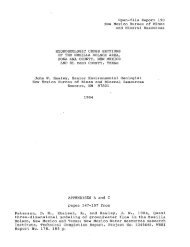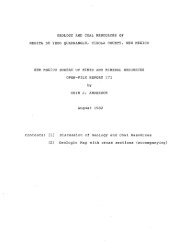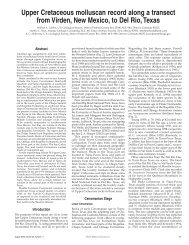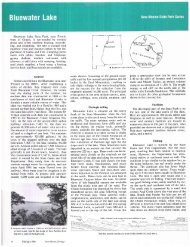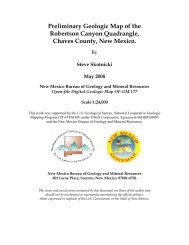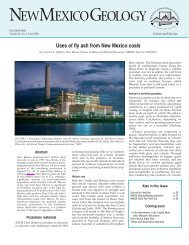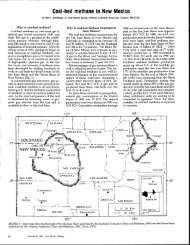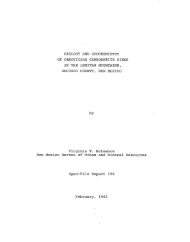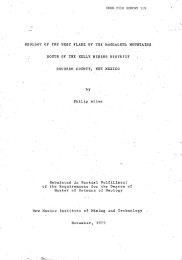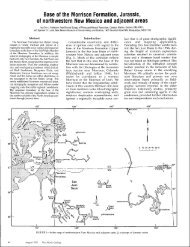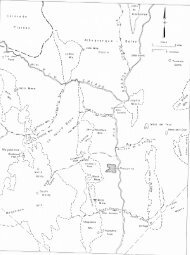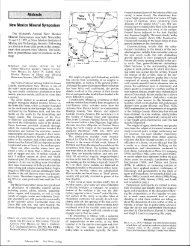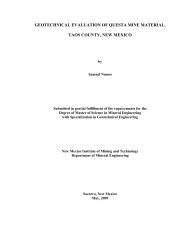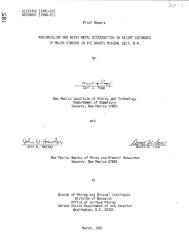Preliminary Geologic Map of the Becker Quadrangle, Valencia and ...
Preliminary Geologic Map of the Becker Quadrangle, Valencia and ...
Preliminary Geologic Map of the Becker Quadrangle, Valencia and ...
You also want an ePaper? Increase the reach of your titles
YUMPU automatically turns print PDFs into web optimized ePapers that Google loves.
<strong>Preliminary</strong> <strong>Geologic</strong> <strong>Map</strong> <strong>of</strong> <strong>the</strong><br />
<strong>Becker</strong> <strong>Quadrangle</strong>,<br />
<strong>Valencia</strong> <strong>and</strong> Socorro Counties, New Mexico<br />
By<br />
Amy L. Lu<strong>the</strong>r, Karl E. Kerlstrom, Lea Anne Scott, Maya<br />
Elrick, <strong>and</strong> Sean D. Connell<br />
May, 2005<br />
New Mexico Bureau <strong>of</strong> Geology <strong>and</strong> Mineral Resources<br />
Open-file Digital <strong>Geologic</strong> <strong>Map</strong> OF-GM 100<br />
Scale 1:24,000<br />
This work was supported by <strong>the</strong> U.S. <strong>Geologic</strong>al Survey, National Cooperative <strong>Geologic</strong><br />
<strong>Map</strong>ping Program (STATEMAP) under USGS Cooperative Agreement 06HQPA0003<br />
<strong>and</strong> <strong>the</strong> New Mexico Bureau <strong>of</strong> Geology <strong>and</strong> Mineral Resources.<br />
New Mexico Bureau <strong>of</strong> Geology <strong>and</strong> Mineral Resources<br />
801 Leroy Place, Socorro, New Mexico, 87801-4796<br />
The views <strong>and</strong> conclusions contained in this document are those <strong>of</strong> <strong>the</strong> author <strong>and</strong><br />
should not be interpreted as necessarily representing <strong>the</strong> <strong>of</strong>ficial policies,<br />
ei<strong>the</strong>r expressed or implied, <strong>of</strong> <strong>the</strong> U.S. Government or <strong>the</strong> State <strong>of</strong> New Mexico.
New Mexico Bureau <strong>of</strong> Geology <strong>and</strong> Mineral Resources<br />
A division <strong>of</strong> New Mexico Institute <strong>of</strong> Mining <strong>and</strong> Technology<br />
801 Leroy Place<br />
Socorro, NM 87801-4796<br />
<strong>Becker</strong> 7.5’ <strong>Quadrangle</strong><br />
OF-DM XX<br />
GEOLOGY OF THE BECKER<br />
7.5-MINUTE QUADRANGLE, VALENCIA AND SOCORRO<br />
COUNTIES, NEW MEXICO<br />
by<br />
Amy L. Lu<strong>the</strong>r, Karl E. Karlstrom, Lea Anne Scott, Maya Elrick <strong>and</strong>, Sean D. Connell<br />
<strong>Geologic</strong> mapping by<br />
Amy L. Lu<strong>the</strong>r (Bedrock Geology), Karl E. Karlstrom (Bedrock Geology), Lea Anne Scott (Paleozoic<br />
rocks), Maya Elrick (Paleozoic rocks), Sean D. Connell (Cenozoic Deposits), <strong>and</strong> previous mapping by<br />
Myers, McKay, <strong>and</strong> Sharps (1981)<br />
New Mexico Bureau <strong>of</strong> Mines <strong>and</strong> Mineral Resources<br />
Open-File Report OFDM-XX<br />
May, 2005<br />
Printed --
INTRODUCTION<br />
The <strong>Becker</strong> 7.5-minute quadrangle comprises an area <strong>of</strong> about 160 km 2 (60 mi 2 ) in<br />
<strong>Valencia</strong> Counties <strong>and</strong> Socorro Counties, New Mexico. Most <strong>of</strong> this quadrangle is a part <strong>of</strong> <strong>the</strong><br />
Sevilleta National Wildlife Refuge. The quadrangle lies on <strong>the</strong> boundary between <strong>the</strong> Rio Gr<strong>and</strong>e<br />
rift on <strong>the</strong> west <strong>and</strong> <strong>the</strong> mountainous rift-flank on <strong>the</strong> east. The rift-flank consists <strong>of</strong> <strong>the</strong> Los<br />
Pinos Mountains. <strong>Map</strong>ping <strong>of</strong> this quadrangle was done in conjunction with mapping <strong>of</strong> <strong>the</strong><br />
adjacent Scholle quadrangle, located in <strong>the</strong> sou<strong>the</strong>rn end <strong>of</strong> <strong>the</strong> Manzano Mountains. Past work<br />
in <strong>the</strong> Manzano <strong>and</strong> Los Pinos Mountains were done by Baer (2003), Shastri (1993), Bauer<br />
(1983), Stark (1956), Stark <strong>and</strong> Dapples (1946), Reiche (1949), Myers, McKay, <strong>and</strong> Sharps<br />
(1981), <strong>and</strong> Myers <strong>and</strong> McKay (1972). The geologic map (Plate I) is <strong>the</strong> result <strong>of</strong> additional<br />
detailed field mapping <strong>and</strong> integration <strong>of</strong> <strong>the</strong>se previous works.<br />
<strong>Geologic</strong> mapping was completed in cooperation with <strong>the</strong> University <strong>of</strong> New Mexico<br />
(UNM) <strong>and</strong> <strong>the</strong> New Mexico Bureau <strong>of</strong> Geology <strong>and</strong> Mineral Resources (NMBGMR). The<br />
topographic base for <strong>the</strong> geologic map is <strong>the</strong> <strong>Becker</strong> <strong>Quadrangle</strong>, 7.5-minute topographic series,<br />
published by <strong>the</strong> United States <strong>Geologic</strong>al Survey at a scale <strong>of</strong> 1:24,000 (one inch equals 2000<br />
feet). For this map, Cenozoic deposits, mapped by Sean Connell, were mapped at a scale <strong>of</strong><br />
1:24,000. This mapping was aided by <strong>the</strong> used <strong>of</strong> 1996-vintage aerial photographs. These maps<br />
were enlarged to a scale <strong>of</strong> 1:12,000 for transfer on <strong>the</strong> final map (Plate I). Pennsylvanian units<br />
mapped by Lea Anne Scott <strong>and</strong> Maya Elrick, as well as Precambrian units mapped by Karl<br />
Karlstrom <strong>and</strong> Amy Lu<strong>the</strong>r were mapped at a scale <strong>of</strong> 1:12,000. Contacts for Paleozoic maps<br />
were checked against aerial photographs at a scale <strong>of</strong> 1:24,000, enlarged, <strong>and</strong> transferred to <strong>the</strong><br />
final 1:12,000-scale map for compilation.<br />
3
Principal contributions <strong>and</strong> revisions that have refined <strong>the</strong> structure <strong>and</strong> stratigraphy <strong>of</strong><br />
this quadrangle include: 1) a revision <strong>of</strong> Pennsylvanian stratigraphy to correspond with lithology,<br />
ra<strong>the</strong>r than fusulinid biostratigraphy as defined by Myers et al. (1981) <strong>and</strong> Myers (1977); 2)<br />
differentiation <strong>of</strong> an additional lower unit in <strong>the</strong> Permian Abo Formation; 3) refinement <strong>of</strong><br />
contacts in Paleozoic units; 4) refinement <strong>of</strong> structures within Paleozoic units; 5) differentiation<br />
<strong>and</strong> correlation <strong>of</strong> Proterozoic metasedimentary <strong>and</strong> metavolcanic units with o<strong>the</strong>r parts <strong>of</strong> <strong>the</strong><br />
Manzano-S<strong>and</strong>ia Mountains; 6) delineation <strong>of</strong> previously unmapped Precambrian structures <strong>and</strong><br />
refinement <strong>of</strong> <strong>the</strong> timing <strong>of</strong> <strong>the</strong>se structures; 7) refinement <strong>of</strong> Paleozoic <strong>and</strong> younger structures<br />
<strong>and</strong> <strong>the</strong>ir relative movement sense; 8) refined mapping <strong>of</strong> range-bounding structures; <strong>and</strong> 9)<br />
differentiation <strong>of</strong> <strong>the</strong> Cenozoic (mostly Pleistocene <strong>and</strong> Holocene) stratigraphy along <strong>the</strong> western<br />
front <strong>of</strong> <strong>the</strong> Los Pinos Mountains <strong>and</strong> in <strong>the</strong> Abo Arroyo drainage system.<br />
Two major revisions to <strong>the</strong> Paleozoic stratigraphy established by Myers (1977) were<br />
undertaken in <strong>the</strong> current mapping effort. 1) The Pennsylvanian units within <strong>the</strong> Wild Cow<br />
Formation <strong>of</strong> <strong>the</strong> Madera Group were subdivided <strong>and</strong> mapped as 5 different informal units (IPm-<br />
1 through IPm-5). These informal units were measured <strong>and</strong> described in a total <strong>of</strong> 5 locations, 3<br />
<strong>of</strong> which are located on <strong>the</strong> adjoining Scholle quadrangle <strong>and</strong> 2 <strong>of</strong> which are located on <strong>the</strong><br />
<strong>Becker</strong> quadrangle. Informal units are based on outcrop patterns <strong>of</strong> laterally persistent,<br />
mappable cliff-forming (dominated by limestone) <strong>and</strong> slope-forming intervals (dominated by<br />
fine marine <strong>and</strong> nonmarine(?) siliciclastic rocks). Myers’ members were used only when readily<br />
identified in <strong>the</strong> field; those members defined using fusulinid foraminifera biostratigraphy were<br />
not utilized. This refinement <strong>of</strong> Pennsylvanian units allowed for better mapping <strong>of</strong> structures<br />
affecting Paleozoic units. Recently, Kues (2001) suggested that <strong>the</strong> Wild Cow Formation is<br />
essentially <strong>the</strong> same unit as <strong>the</strong> Atrasado Formation recognized to <strong>the</strong> west across <strong>the</strong> Rio Gr<strong>and</strong>e<br />
4
Rift (~80 km) in <strong>the</strong> Lucero Mesa region, <strong>and</strong> recommended changing <strong>the</strong> name to reflect this<br />
similarity. Similarly, <strong>the</strong> Los Moyos Limestone is equivalent to <strong>the</strong> Gray Mesa Formation. For<br />
our mapping purposes, we did not assign any formal nomenclature to <strong>the</strong> Pennsylvanian units,<br />
but ra<strong>the</strong>r mapped large-scale patterns in lithology through inferences made about cliff- versus<br />
slope-forming intervals. 2) An informal unit in <strong>the</strong> basal Abo Formation was mapped separately<br />
based on a difference in grain size, sedimentary structures, color, <strong>and</strong> outcrop pattern. This basal<br />
unit is not regionally extensive, as it much thinner on <strong>the</strong> <strong>Becker</strong> quadrangle than in <strong>the</strong> Scholle<br />
quadrangle to <strong>the</strong> east, <strong>and</strong> does not extend across <strong>the</strong> Rio Gr<strong>and</strong>e Rift to <strong>the</strong> Lucero Mesa Area<br />
(~80 km; Lucas <strong>and</strong> Ziegler, 2004).<br />
Faults splaying <strong>of</strong>f <strong>the</strong> main Montosa fault were mapped by Steve Haden several years<br />
ago <strong>and</strong> are incorporated into <strong>the</strong> map along <strong>the</strong> Montosa fault; <strong>the</strong>se faults were field checked<br />
for location accuracy. Pennsylvanian contacts were completely remapped in <strong>the</strong> current mapping<br />
effort. The location <strong>of</strong> <strong>the</strong> Montosa fault was checked in <strong>the</strong> field <strong>and</strong> modified slightly where<br />
necessary from previous mapping by Myers et al. (1981). In addition, contacts between <strong>the</strong><br />
uppermost Pennsylvanian unit (IPm5) <strong>and</strong> <strong>the</strong> Bursum Formation (Pb) were mapped both in <strong>the</strong><br />
field <strong>and</strong> from aerial photography, resulting in only slight modification to Myers et al. (1981)<br />
contacts between <strong>the</strong>se units.<br />
Cenozoic deposits were mapped along <strong>the</strong> range fronts <strong>of</strong> <strong>the</strong> sou<strong>the</strong>rn Manzano <strong>and</strong><br />
nor<strong>the</strong>rn Los Pinos Mountains. This mapping substantially improved earlier mapping by Myers,<br />
Sharps, <strong>and</strong> McKay (1981). In particular, piedmont-slope deposits associated with <strong>the</strong> western<br />
fronts <strong>of</strong> <strong>the</strong> Manzano <strong>and</strong> Los Pinos Mountains were differentiated from deposits associated<br />
with <strong>the</strong> modern <strong>and</strong> ancestral Abo Arroyo drainage system, which enters <strong>the</strong> Albuquerque basin<br />
between <strong>the</strong>se two ranges. No obvious signs <strong>of</strong> Pleistocene or Holocene range-front <strong>and</strong><br />
5
intrabasinal faulting (i.e., topographic scarps <strong>and</strong> <strong>of</strong>fset strata) were recognized during mapping<br />
<strong>of</strong> <strong>the</strong> <strong>Becker</strong> quadrangle.<br />
Precambrian units <strong>and</strong> structures were remapped with resulting new insights into <strong>the</strong><br />
tectonic evolution <strong>of</strong> central New Mexico. The Paleoproterozoic rocks <strong>of</strong> <strong>the</strong> <strong>Becker</strong> quadrangle<br />
<strong>and</strong> adjacent Scholle quadrangle had been mapped by Myers et al. (1981) <strong>and</strong> Myers (1977),<br />
respectively, as a west-dipping homoclinal succession with Sais Quartzite at <strong>the</strong> base <strong>and</strong><br />
Sevilleta Metarhyolite at <strong>the</strong> top. New mapping, <strong>and</strong> identification <strong>of</strong> cross bedding, graded<br />
bedding, <strong>and</strong> o<strong>the</strong>r younging indicators shows that <strong>the</strong> stratigraphic order is reversed, with<br />
Sevilleta Metarhyolite near <strong>the</strong> base <strong>of</strong> <strong>the</strong> section <strong>and</strong> Sais <strong>and</strong> Blue Ridge Formation near <strong>the</strong><br />
top. The rocks were folded into a tight to isoclinal regional-scale synclinorium cored by schist<br />
<strong>and</strong> rhyolite <strong>of</strong> <strong>the</strong> Blue Springs Formation. The axial plane <strong>of</strong> this syncline strikes NE in <strong>the</strong><br />
<strong>Becker</strong> quadrangle, gets folded into an F3 anticline, <strong>and</strong> is truncated by <strong>the</strong> Priest pluton in <strong>the</strong><br />
adjacent Scholle quadrangle. The resulting complex interference patterns are delineated by<br />
interlayered quartzite <strong>and</strong> schist units <strong>and</strong> <strong>the</strong> complexity <strong>of</strong> fold overprinting <strong>and</strong> cross cutting<br />
schistosities are portrayed by structural symbols in <strong>the</strong> new mapping.<br />
Ano<strong>the</strong>r contribution involves a better underst<strong>and</strong>ing <strong>of</strong> <strong>the</strong> nature <strong>of</strong> tectonism<br />
associated with emplacement <strong>of</strong> <strong>the</strong> Priest pluton. In <strong>the</strong> Scholle quadrangle, at least portions <strong>of</strong><br />
<strong>the</strong> sou<strong>the</strong>rn contact dips about 30 degrees southward, as shown by mapping <strong>of</strong> <strong>the</strong> contact<br />
across rugged topography. Thus, Paleoproterozoic units <strong>of</strong> <strong>the</strong> Scholle quadrangle are in <strong>the</strong> ro<strong>of</strong><br />
<strong>of</strong> <strong>the</strong> pluton. Strong development <strong>of</strong> fabric <strong>and</strong> metamorphic isograds reflect <strong>the</strong>rmal influences<br />
from <strong>the</strong> pluton. Increase in intensity <strong>of</strong> S3 as <strong>the</strong> contact is approached, as well as porhyroblast-<br />
matrix relationships, suggest that <strong>the</strong> pluton was synchronous with S3 <strong>and</strong> post- S2.<br />
6
COMMENTS TO MAP USERS<br />
<strong>Map</strong>ping <strong>of</strong> this quadrangle was funded by a matching-funds grant from <strong>the</strong> 2003-2005<br />
STATEMAP program <strong>of</strong> <strong>the</strong> U.S. <strong>Geologic</strong>al Survey, National Cooperative <strong>Geologic</strong> <strong>Map</strong>ping<br />
Program, under USGS award number 00HQAG0078, to <strong>the</strong> New Mexico Bureau <strong>of</strong> Geology <strong>and</strong><br />
Mineral Resources (Dr. Peter Scholle, Director; Dr. Paul W. Bauer, P.I. <strong>and</strong> <strong>Geologic</strong> <strong>Map</strong>ping<br />
Program Manager).<br />
This quadrangle map has been open-filed in order to make it available as soon as<br />
possible. The map has not been reviewed according to New Mexico Bureau <strong>of</strong> Geology <strong>and</strong><br />
Mineral Resources st<strong>and</strong>ards, <strong>and</strong> due to <strong>the</strong> ongoing nature <strong>of</strong> work in <strong>the</strong> area, revision <strong>of</strong> this<br />
map is likely. As such, dates <strong>of</strong> revision are listed in <strong>the</strong> upper right corner <strong>of</strong> <strong>the</strong> map <strong>and</strong> on<br />
<strong>the</strong> accompanying report. The contents <strong>of</strong> <strong>the</strong> report <strong>and</strong> map should not be considered final<br />
<strong>and</strong> complete until it is published by <strong>the</strong> New Mexico Bureau <strong>of</strong> Geology <strong>and</strong> Mineral<br />
Resources.<br />
A geologic map graphically displays information on <strong>the</strong> distribution, nature, orientation,<br />
<strong>and</strong> age relationships <strong>of</strong> rock <strong>and</strong> surficial units <strong>and</strong> <strong>the</strong> occurrence <strong>of</strong> structural features such as<br />
faults <strong>and</strong> folds. <strong>Geologic</strong> contacts are irregular surfaces that form boundaries between different<br />
types or ages <strong>of</strong> units. Data depicted on this geologic map are based on field geologic mapping,<br />
compilation <strong>of</strong> published <strong>and</strong> unpublished work, <strong>and</strong> photogeologic interpretation. Locations <strong>of</strong><br />
contacts are not surveyed, but are plotted by interpretation <strong>of</strong> <strong>the</strong> position <strong>of</strong> a given contact onto<br />
a topographic base map; <strong>the</strong>refore, <strong>the</strong> accuracy <strong>of</strong> contact locations depends on <strong>the</strong> scale <strong>of</strong><br />
mapping <strong>and</strong> <strong>the</strong> interpretation <strong>of</strong> <strong>the</strong> geologist. Significant portions <strong>of</strong> <strong>the</strong> study area may have<br />
been mapped at scales smaller than <strong>the</strong> final map; <strong>the</strong>refore, <strong>the</strong> user should be aware <strong>of</strong><br />
potentially significant variations in map detail. Site-specific conditions should be verified by<br />
7
detailed surface mapping or subsurface exploration. Topographic <strong>and</strong> cultural changes associated<br />
with recent development may not be shown everywhere.<br />
The cross-sections in this report are constructed based on surficial geology, <strong>and</strong> where<br />
available, subsurface <strong>and</strong> geophysical data. The cross sections are interpretive <strong>and</strong> should be<br />
used as an aid to underst<strong>and</strong> <strong>the</strong> geologic framework <strong>and</strong> not used as <strong>the</strong> sole source <strong>of</strong> data in<br />
locating or designing wells, buildings, roads, or o<strong>the</strong>r structures.<br />
The views <strong>and</strong> conclusions contained in this document are those <strong>of</strong> <strong>the</strong> authors <strong>and</strong><br />
should not be interpreted as necessarily representing <strong>the</strong> <strong>of</strong>ficial policies, ei<strong>the</strong>r expressed or<br />
implied, <strong>of</strong> <strong>the</strong> U.S. Government.<br />
Accessibility<br />
The sou<strong>the</strong>rn portion <strong>of</strong> <strong>the</strong> <strong>Becker</strong> quadrangle is within <strong>the</strong> Sevilleta National Wildlife<br />
Refuge <strong>and</strong> is only accessible with a permit. Once attained, <strong>the</strong> area can be accessed <strong>of</strong>f <strong>of</strong> N.M.<br />
Highway 60 through Bernardo, <strong>and</strong> onto <strong>the</strong> dirt road that belongs to <strong>the</strong> Refuge. The far eastern<br />
portion is BLM l<strong>and</strong> <strong>and</strong> is also accessible from US Highway 60. The nor<strong>the</strong>rn half <strong>of</strong> <strong>the</strong> map is<br />
located within <strong>the</strong> Belen Grant <strong>and</strong> <strong>the</strong> Casa Colorada Grant. The Atchison, Topeka, <strong>and</strong> Santa<br />
Fe railroad track also runs through <strong>the</strong> nor<strong>the</strong>rn half <strong>of</strong> <strong>the</strong> <strong>Becker</strong> quadrangle.<br />
<strong>Geologic</strong> <strong>and</strong> Physiographic Setting<br />
The majority <strong>of</strong> <strong>the</strong> <strong>Becker</strong> quadrangle is covered with Quaternary deposits covering <strong>the</strong><br />
Santa Fe Group (basin fill associated with <strong>the</strong> Albuquerque basin <strong>and</strong> Rio Gr<strong>and</strong>e rift). The<br />
sou<strong>the</strong>astern potion <strong>of</strong> <strong>the</strong> quadrangle consists <strong>of</strong> structurally complex Paleoproterozoic rocks<br />
overlain by Upper Pennsylvanian <strong>and</strong> Lower Permian strata. Proterozoic units mainly consist <strong>of</strong><br />
8
quartzite, schist, <strong>and</strong> rhyolite rock types that were ductiley deformed <strong>and</strong> folded into a regional<br />
scale nor<strong>the</strong>ast trending overturned syncline. The Paleozoic strata that overlies <strong>the</strong> Precambrian<br />
units have been folded into a monocline, mainly on <strong>the</strong> Laramide Montosa Fault. East <strong>of</strong> <strong>the</strong><br />
Montosa Fault <strong>the</strong> Paleozoic beds gently (≤ 10°) dip to <strong>the</strong> east into <strong>the</strong> Great Plains region <strong>of</strong> <strong>the</strong><br />
Scholle <strong>Quadrangle</strong>.<br />
Abo Arroyo is a large drainage <strong>the</strong> flows through <strong>the</strong> <strong>Becker</strong> quadrangle <strong>and</strong> divides<br />
drainages (<strong>and</strong> associated deposits) associated with <strong>the</strong> small mountain-front drainages <strong>of</strong> <strong>the</strong><br />
sou<strong>the</strong>rn Manzano <strong>and</strong> Los Pinos Mountains. Piñon Canyon lies just east <strong>of</strong> Whiteface<br />
Mountain, <strong>the</strong> tallest peak in <strong>the</strong> quadrangle at 7530 feet (2295 m) above seal level.<br />
STRATIGRAPHY<br />
All map units are described in Table 1. The age <strong>and</strong> stratigraphic relationships <strong>of</strong> <strong>the</strong>se<br />
map units are summarized in <strong>the</strong> Correlation <strong>of</strong> <strong>Map</strong> Units.<br />
Quaternary <strong>and</strong> Pliocene Deposits<br />
Quaternary <strong>and</strong> Pliocene alluvial deposits <strong>of</strong> <strong>the</strong> <strong>Becker</strong> 7.5-minute quadrangle contain<br />
variable proportions <strong>of</strong> gravel, s<strong>and</strong> <strong>and</strong> silt, deposited by intermittent <strong>and</strong> ephemeral streams;<br />
mass-movement deposits typically occur on hill slopes. <strong>Map</strong>-unit differentiation is based on<br />
stratigraphic position (inset or depositional relations), surface morphology, degree <strong>of</strong> soil-pr<strong>of</strong>ile<br />
development (see Gile et al., 1981) <strong>and</strong> sedimentary character. Deposits are a mixture <strong>of</strong> poorly<br />
sorted, poorly to moderately stratified, clast- <strong>and</strong> matrix-supported alluvium, having<br />
predominantly gravelly to s<strong>and</strong>y textures; silt-clay textures are locally common. Clast<br />
constituents typically reflect bedrock composition <strong>of</strong> local upl<strong>and</strong> drainage systems associated<br />
9
with <strong>the</strong> western flank <strong>of</strong> <strong>the</strong> Los Pinos Mountains. Alluvial deposits are 12- to 21-m thick <strong>and</strong><br />
unconformably overlie older rocks. Alluvial deposits are divided into three major classes: 1)<br />
valley-fill alluvium, 2) piedmont-slope alluvium, <strong>and</strong> 3) colluvium <strong>and</strong> spring deposits.<br />
Forward gravity modeling <strong>and</strong> seismic reflection pr<strong>of</strong>iling suggest that <strong>the</strong> Neogene basin<br />
fill <strong>and</strong> overlying Quaternary deposits are about 1 km in thickness (Cape et al., 1983). It is not<br />
clear how thick <strong>the</strong> Neogene succession is on <strong>the</strong> hangingwall <strong>of</strong> <strong>the</strong> Los Pinos range-front faults<br />
on <strong>the</strong> <strong>Becker</strong> quadrangle, but previous mapping on <strong>the</strong> nearby <strong>Becker</strong> SW <strong>and</strong> Cerro Montosa<br />
quadrangles (Myers et al., 1986) show Madera Group limestone exposed on <strong>the</strong> range-front<br />
hangingwall block <strong>and</strong> are overlain by more than 6 m <strong>of</strong> Plio-Pleistocene conglomeratic deposits<br />
that bury a pediment cut onto upper Paleozoic sedimentary rocks. The presence <strong>of</strong> a<br />
topographically high inlier <strong>of</strong> late Oligocene volcanic rocks (Turututu, or Black Butte, K-AR<br />
date <strong>of</strong> 24.3 Ma, Bachman <strong>and</strong> Mehnert, 1978) on <strong>the</strong> adjoining Black Butte quadrangle,<br />
suggests that <strong>the</strong> entire Neogene succession is likely thin. Oligocene volcaniclastic rocks are<br />
exposed on <strong>the</strong> La Joya <strong>and</strong> <strong>Becker</strong> SW quadrangle, as well as on <strong>the</strong> hangingwall <strong>of</strong> <strong>the</strong><br />
Manzano Mountains frontal fault at Trigo Canyon, on <strong>the</strong> Capilla Peak quadrangle (Karlstrom et<br />
al., 2001; Connell et al., 2002). The distribution <strong>of</strong> <strong>the</strong>se Oligocene rocks suggest that <strong>the</strong><br />
Neogene deposits <strong>of</strong> <strong>the</strong> Santa Fe Group <strong>and</strong> younger Quaternary deposits is present beneath<br />
much <strong>of</strong> <strong>the</strong> western parts <strong>of</strong> <strong>the</strong> <strong>Becker</strong> quadrangle.<br />
Paleozoic Rocks<br />
The Pennsylvanian strata exposed within <strong>the</strong> quadrangle include <strong>the</strong> siliciclastic S<strong>and</strong>ia<br />
Formation, mixed carbonates <strong>and</strong> siliciclastics <strong>of</strong> <strong>the</strong> Pennsylvanian Madera Group <strong>and</strong> <strong>the</strong><br />
Permian Bursum Formation, <strong>and</strong> siliciclastics <strong>of</strong> <strong>the</strong> Permian Abo Formation. The Pennsylvanian<br />
10
Madera Group was deposited within shallow seaways that formed in <strong>the</strong> basins <strong>of</strong> <strong>the</strong> Ancestral<br />
Rocky Mountains <strong>and</strong> for this mapping effort, was mapped as a series <strong>of</strong> cliff- <strong>and</strong> slope-<br />
formers. The overlying Permian Bursum Formation is interpreted to represent deposition in both<br />
marine <strong>and</strong> fluvial environments, while <strong>the</strong> overlying Permian Abo Formation represents<br />
deposition in an entirely continental setting, including fluvial <strong>and</strong> rare lacustrine environments.<br />
The lower portion <strong>of</strong> <strong>the</strong> Abo unit mapped may represent a fluvial environment that was not<br />
laterally extensive, given that <strong>the</strong> unit thins to <strong>the</strong> west <strong>and</strong> north.<br />
Regional patterns in Los Moyos Limestone <strong>of</strong> <strong>the</strong> Madera Group<br />
According to Myers (1977), unit IPm-1 (<strong>the</strong> Los Moyos Limestone <strong>of</strong> <strong>the</strong> Madera Group)<br />
is Desmoinesian in age. Kues (2001) recommends revising this name to <strong>the</strong> Gray Mesa<br />
Formation due to similarities in lithology <strong>and</strong> age. Approximately 80 km directly west across <strong>the</strong><br />
Rio Gr<strong>and</strong>e Rift, <strong>the</strong> Gray Mesa Formation (Mesa Sarca; Scott <strong>and</strong> Elrick, 2004) is well-exposed<br />
in <strong>the</strong> Lucero uplift area. In <strong>the</strong> Lucero uplift area, <strong>the</strong> Gray Mesa Formation is significantly<br />
thicker (~290 m at Mesa Sarca versus ~170 m in Scholle quadrangle) <strong>and</strong> is characterized by five<br />
mappable slope- to limestone cliff-forming units (or sequences; 20-80 m) representing deposition<br />
during distinct transgressive-regressive intervals. Transgressive-regressive sequences were not<br />
recognized within <strong>the</strong> Scholle quadrangle. However, several key similarities were observed in<br />
both units: 1) chert is abundant, as isolated pods, as a pervasive, interlocking network<br />
overprinting <strong>the</strong> host rock, <strong>and</strong> as silicified fossils, 2) fossil abundance <strong>and</strong> diversity are similar,<br />
3) coarse-grained siliciclastic s<strong>and</strong>stone deposits are generally lacking, <strong>and</strong> 4) laterally persistent<br />
diagenetic features including diagenetic mottling <strong>and</strong> laminar black calcretes are present on<br />
many bed tops.<br />
11
Proterozoic Rocks<br />
Proterozoic rocks in <strong>the</strong> Scholle <strong>and</strong> <strong>Becker</strong> quadrangles consist <strong>of</strong> ductiley deformed <strong>and</strong><br />
metamorphosed volcanic, sedimentary <strong>and</strong> plutonic rocks. Our interpretation is that <strong>the</strong>se rocks<br />
formed in volcanic arcs <strong>and</strong> related arc basins along <strong>the</strong> growing sou<strong>the</strong>rn periphery <strong>of</strong> cratonic<br />
North America ca. 1.67-1.65 Ga (Karlstrom et al., 2004). The metamorphic rock sequence is<br />
described in Table 1. Due to <strong>the</strong> polyphase deformational history, construction <strong>of</strong> a coherent<br />
stratigraphy has been controversial <strong>and</strong> h<strong>and</strong>led differently by different authors. Based on new<br />
mapping in <strong>the</strong> Manzano Peak, Scholle, <strong>and</strong> <strong>Becker</strong> quadrangles, <strong>the</strong>re is an emerging regionally<br />
coherent stratigraphy that involves a lower metavolcanic suite (mafic <strong>and</strong> felsic rocks) overlain<br />
by a sedimentary succession that gets cleaner <strong>and</strong> more mature upward, towards massive white,<br />
relatively clean quartzite, overlying schist, <strong>and</strong> an upper rhyolite.<br />
The stratigraphy is most completely exposed in <strong>the</strong> nearby Manzano Peak <strong>and</strong> <strong>Becker</strong><br />
quadrangles. The basal unit is <strong>the</strong> Sevilleta metarhyolite (Xsr) that has been dated as 1662 +- 1<br />
Ma (Shastri, 1993). The Sevilleta metarhyolite is interpreted to be <strong>the</strong> oldest unit <strong>of</strong> <strong>the</strong> area<br />
based on its stratigraphic relationship with o<strong>the</strong>r units. The Sevilleta metarhyolite <strong>of</strong> <strong>the</strong><br />
Manzano Peak, <strong>Becker</strong>, <strong>and</strong> Scholle quadrangles forms a semi-continuous outcrop b<strong>and</strong> along<br />
<strong>the</strong> west slope <strong>of</strong> <strong>the</strong> mountain front. This unit was divided by Myer et al (1981) into several<br />
mappable rhyolite units based on phenocryst content <strong>and</strong> o<strong>the</strong>r characteristics, <strong>and</strong> <strong>the</strong>se<br />
subdivisions are generally retained here. In many areas, metarhyolite is interfingered with mafic<br />
units <strong>of</strong> <strong>the</strong> metavolcanic package including amphibolites (metabasalt <strong>and</strong> metagabbro) <strong>and</strong><br />
mafic schists; <strong>the</strong>se are interpreted as part <strong>of</strong> <strong>the</strong> “greenstone” packages mapped elsewhere in<br />
<strong>the</strong> Manzano <strong>and</strong> Los Pinos Mountains (Bauer, 1993). The overlying metasedimentary<br />
12
succession is a complex sequence <strong>of</strong> phyllite <strong>and</strong> metamorphosed metalithic arenite. Near <strong>the</strong><br />
base <strong>of</strong> <strong>the</strong> sedimentary succession are lenticular outcrops <strong>of</strong> dacitic breccia that resemble <strong>the</strong><br />
Lacorocah metadacite <strong>of</strong> Parchman (1980). The lithic arenite succession is compositionally<br />
variable <strong>and</strong> contains more pelitic layers that contain garnet <strong>and</strong> staurolite schist. All <strong>of</strong> <strong>the</strong>se<br />
rocks are intensely interlayered with amphibolites. The amphibolites have variable texture: some<br />
are coarse grained <strong>and</strong> resemble gabbroic sills <strong>and</strong> dikes; some are fine grained <strong>and</strong> contain<br />
vesicles <strong>and</strong> o<strong>the</strong>r evidence that <strong>the</strong>y were eruptive units. The striped map pattern <strong>of</strong> <strong>the</strong><br />
amphibolite within lithic arenite was referred to by Myer et al. as <strong>the</strong> “mixed flow” unit.<br />
The arenites grade upward into cleaner metasediments <strong>of</strong> <strong>the</strong> White Ridge Quartzite <strong>and</strong><br />
related Sais Quartzite units, which are separated by a pelitic schist unit named <strong>the</strong> Estadio Schist,<br />
for excellent outcrops in Estadio Canyon in <strong>the</strong> Manzano Peak quadrangle. The Sais Quartzite is<br />
overlain by <strong>the</strong> Blue Springs Quartzite, Blue Spring Schist, Blue Spring Rhyolite, <strong>and</strong> an upper<br />
Blue Spring Schist. The Blue Springs metarhyolite is b<strong>and</strong>ed metarhyolite defined by mm-10’s<br />
cm scale compositional b<strong>and</strong>s.<br />
Metasedimentary rocks is intruded by two different plutons in this region. The Los Pinos<br />
granite <strong>of</strong> <strong>the</strong> <strong>Becker</strong> quadrangle appears to truncate S2 foliation in <strong>the</strong> <strong>Becker</strong> quadrangle <strong>and</strong><br />
yields a U-Pb zircon age <strong>of</strong> 1655 +-3. This is similar in age to <strong>the</strong> strongly deformed Monte<br />
Largo quartz monzonite that intrudes <strong>the</strong> Blue Springs package in <strong>the</strong> NW corner <strong>of</strong> <strong>the</strong><br />
Manzano Peak quadrangle that yields a U-Pb zircon date <strong>of</strong> 1656+/-10 Ma (Bauer et al., 1993).<br />
In <strong>the</strong> Scholle quadrangle, <strong>the</strong> Priest Pluton intrudes <strong>the</strong> Blue Springs Formation in <strong>the</strong> northwest<br />
part <strong>of</strong> <strong>the</strong> quadrangle. This pluton yields a U-Pb zircon date <strong>of</strong> 1443 +/- 10 Ma (Thompson et<br />
al. 1996). An extensive metamorphic contact aureole is mapped at <strong>the</strong> margin <strong>of</strong> <strong>the</strong> Priest Pluton<br />
with concentric isograds extending away from <strong>the</strong> pluton (Thompson et al. 1996).<br />
13
STRUCTURAL GEOLOGY<br />
Folds, faults <strong>and</strong> shear zones in <strong>the</strong> <strong>Becker</strong> <strong>and</strong> Scholle quadrangles exhibit several styles<br />
<strong>of</strong> deformation related to different periods <strong>of</strong> tectonic activity since <strong>the</strong> Proterozoic. This section<br />
discusses some <strong>of</strong> <strong>the</strong> recent refinements to <strong>the</strong> structure <strong>of</strong> <strong>the</strong> study area.<br />
There is evidence for multiple generations <strong>of</strong> deformation including: D1, D2, <strong>and</strong> D3<br />
(Baer, 2004). D1 involved west- directed thrusting. Field observations include an early foliation,<br />
S1, which is generally subparallel to bedding <strong>and</strong> is seen in thin section, or associated with minor<br />
nappe folds (Karlstrom et al. 2001). These F1 folds are subsequently refolded by F2 folds. F2<br />
folds in <strong>the</strong> <strong>Becker</strong> quadrangle trend to <strong>the</strong> nor<strong>the</strong>ast, <strong>and</strong> have shallow plunge. D2 involved<br />
upright folding <strong>and</strong> establishment <strong>of</strong> <strong>the</strong> main NE-trending cleavage in <strong>the</strong> rocks. The large F2<br />
synclinorium in <strong>the</strong> eastern part <strong>of</strong> <strong>the</strong> <strong>Becker</strong> <strong>Quadrangle</strong>, <strong>and</strong> continuing into <strong>the</strong> Scholle<br />
quadrangle is named <strong>the</strong> Manzano Peak synclinorium (Baer, 2004). Preserved cross bedding in<br />
<strong>the</strong> quartzite units <strong>and</strong> bedding-cleavage relationships both help define it as an upright syncline.<br />
It is refolded in <strong>the</strong> Scholle quadrangle <strong>and</strong> truncated at <strong>the</strong> sou<strong>the</strong>rn margin <strong>of</strong> <strong>the</strong> Priest pluton<br />
indicating <strong>the</strong> fold developed before <strong>the</strong> pluton was emplaced. Its axial plane dips steeply to <strong>the</strong><br />
west, throughout <strong>the</strong> <strong>Becker</strong> quadrangle.<br />
F3 folds fold, kink, or deflect <strong>the</strong> main S2 schistosity. D3 can be shown to be pluton<br />
related shortening because <strong>of</strong> porphyroblast-matrix studies using contact minerals <strong>and</strong><br />
intensification <strong>of</strong> S3 as <strong>the</strong> pluton is approached.<br />
The Montosa reverse fault <strong>and</strong> associated monocline is well exposed in <strong>the</strong> eastern<br />
<strong>Becker</strong> <strong>and</strong> northwestern Scholle quadrangles. This structure is <strong>of</strong> presumed Laramide age as it<br />
is typical <strong>of</strong> Rocky Mountain uplifts all along <strong>the</strong> front ranges. Essentially flat lying Paleozoic<br />
14
sedimentary rocks <strong>of</strong> <strong>the</strong> Great Plains to <strong>the</strong> east are folded into a monoclinal flexure with a steep<br />
to overturned limb that parallels <strong>the</strong> fault. Amount <strong>of</strong> throw on <strong>the</strong> fault/monocline is estimated<br />
to be 1000 meters based on restorable cross section, but significant right lateral strike slip on <strong>the</strong><br />
fault was also likely (ref).<br />
The Manzano normal fault is <strong>the</strong> rift –bounding fault forms <strong>the</strong> west margin <strong>of</strong> <strong>the</strong><br />
mountains. It is concealed by thin Tertiary/Quaternary deposits, but we estimate a throw <strong>of</strong> about<br />
1500 meters based on restorable cross sections. Paleozoic <strong>and</strong> Mesozoic strata are inferred to<br />
form a “bench” on <strong>the</strong> downthrown side based on projecting outcrops <strong>and</strong> structural styles<br />
northwards (<strong>and</strong> down) into <strong>the</strong> line <strong>of</strong> cross section from <strong>the</strong> Los Pinos Mountains to <strong>the</strong> south<br />
(Myer et al., 1986). Normal slip on <strong>the</strong> Manzano fault is assumed to decrease south towards Abo<br />
Arroyo.<br />
PROTEROZOIC METAMORPHISM<br />
The regional metamorphic grade in much <strong>of</strong> <strong>the</strong> quadrangle, between <strong>the</strong> Monte Largo<br />
shear zone <strong>and</strong> <strong>the</strong> Priest pluton, is amphibolite grade. Northwest <strong>of</strong> <strong>the</strong> Monte Largo shear zone,<br />
<strong>the</strong> rocks are greenschist grade. Mafic assemblages include actinolite (not hornblende), chlorite,<br />
sodic plagioclase, epidote quartz <strong>and</strong> white mica, suggesting temperatures <strong>of</strong> 500�C. The contact aureole <strong>of</strong> <strong>the</strong> Priest pluton is defined by two<br />
isograds that have been documented by Thompson (1993). These isogrades separate <strong>the</strong> aureole<br />
into three zones: <strong>the</strong> garnet zone, <strong>the</strong> staurolite zone <strong>and</strong> <strong>the</strong> sillimanite zone. The boundary<br />
between <strong>the</strong> garnet zone <strong>and</strong> <strong>the</strong> staurolite zone represents <strong>the</strong> reaction garnet +chlorite �<br />
biotite+ staurolite (<strong>the</strong> staurolite-in isograde). The boundary between <strong>the</strong> staurolite zone <strong>and</strong> <strong>the</strong><br />
15
sillimanite zone is represented by <strong>the</strong> reaction <strong>of</strong> <strong>and</strong>alusite � sillamanite <strong>and</strong> is also <strong>the</strong><br />
temperature at which potassium feldspar is first seen in pelitic rocks (called <strong>the</strong> second<br />
sillimanite isograd ~650�C).<br />
Foliation- porphyroblasts relationships support <strong>the</strong> interpretation that amphibolite grade<br />
temperatures were probably achieved prior to <strong>the</strong> emplacement <strong>of</strong> <strong>the</strong> Priest pluton. For instance,<br />
<strong>the</strong>re are kyanite inclusions within contact metamorphic <strong>and</strong>alusite porphyroblasts. Some garnet<br />
grains have stuarolite inclusions. There is field evidence for two generations <strong>of</strong> staurolite, one<br />
that contains <strong>the</strong> S2 foliation <strong>and</strong> ano<strong>the</strong>r that does not. However, most <strong>of</strong> <strong>the</strong> mineral are contact<br />
minerals that grew at ca. 1430 Ma, during development <strong>of</strong> <strong>the</strong> S3 cleavage. Post-emplacement<br />
retrograde metamorphism is documented by pseudomorphs <strong>of</strong> staurolite replaced by sericite,<br />
chlorite <strong>and</strong> some alteration <strong>of</strong> plagioclase to muscovite. These observations suggest late stage<br />
hydration <strong>of</strong> earlier assemblages, probably during waning stages <strong>of</strong> pluton emplacement.<br />
ACKNOWLEDGEMENTS<br />
Funding for this project was provided by <strong>the</strong> STATEMAP program in conjunction with<br />
<strong>the</strong> New Mexico Bureau <strong>of</strong> Geology <strong>and</strong> Mineral Resources. Access for mapping in <strong>the</strong> <strong>Becker</strong><br />
quadrangle was facilitated by a research permit from <strong>the</strong> Sevilleta preserve.<br />
REFERENCES<br />
Bachman, G. O., <strong>and</strong> Mehnert, H.H., 1978, New K-Ar dates <strong>and</strong> <strong>the</strong> late Pliocene to Holocene<br />
geomorphic history <strong>of</strong> <strong>the</strong> central Rio Gr<strong>and</strong>e region, New Mexico: <strong>Geologic</strong>al Society <strong>of</strong><br />
America, Bulletin, v. 89, p. 283-392.<br />
Baer, S., 2004, <strong>Geologic</strong> <strong>and</strong> tectonic evolution <strong>of</strong> <strong>the</strong> Manzano Peak <strong>Quadrangle</strong>, Manzano<br />
Mountains, New Mexico [M.S. <strong>the</strong>sis]: University <strong>of</strong> New Mexico.<br />
Baer, S.H., Karlstrom, K.E. <strong>and</strong> Bauer, P. (2002) New <strong>Map</strong>ping from <strong>the</strong> Manzano Peak<br />
<strong>Quadrangle</strong>, central New Mexico. GSA Abstracts with Programs.<br />
16
Bates, R.L., Wilpolt, R.H., MacAlpin, A.J., <strong>and</strong> Vorbe, G., 1947, Geology <strong>of</strong> <strong>the</strong> Gran Quivira<br />
<strong>Quadrangle</strong>, New Mexico: New Mexico Bureau <strong>of</strong> Mines <strong>and</strong> Mineral Resources Bulletin<br />
26, 49 p.<br />
Bauer, P. 1982. Precambrian geology <strong>and</strong> tectonics <strong>of</strong> <strong>the</strong> sou<strong>the</strong>rn Manzano Mountains, central<br />
New Mexico. New Mexico <strong>Geologic</strong>al Society Guidebook, 33 rd Field Conference.<br />
Albuquerque Country. p. 211-216.<br />
Bauer, Paul w. 1983. Geology <strong>of</strong> <strong>the</strong> Precambrian rocks <strong>of</strong> <strong>the</strong> sou<strong>the</strong>rn Manzano Mountains,<br />
New Mexico. [Master Thesis] University <strong>of</strong> New Mexico.<br />
Bauer, P. W., Karlstrom, K. E., Bowing, S. A., Smith, A., <strong>and</strong> Goodwin, L. B., 1993, Proterozoic<br />
plutonism <strong>and</strong> regional deformation—new constraints from <strong>the</strong> sou<strong>the</strong>rn Manzano<br />
Mountains, central New Mexico: New Mexico Geology, v. 15, no. 3, p. 49–55.<br />
Behr, R.A., 1999, Structural <strong>and</strong> Thermochronological constraints on <strong>the</strong> movement history <strong>of</strong><br />
<strong>the</strong> Montosa Fault, Central New Mexico. [M.S. Thesis]: New Mexico Institute <strong>of</strong> Mining<br />
<strong>and</strong> Technology, 129 p.<br />
Bowring, S.A., Condie, K., <strong>and</strong> Sumner, W., 1983, Geology <strong>and</strong> U-Pb geochronology <strong>of</strong><br />
Proterozoic rocks in <strong>the</strong> vicinity <strong>of</strong> Socorro, New Mexico: New Mexico <strong>Geologic</strong>al<br />
Society Guidebook 34, p. 137-142.<br />
Cape, C.D., McGeary, S., <strong>and</strong> Thompson, G.A., 1983, Cenozoic normal faulting <strong>and</strong> <strong>the</strong> shallow<br />
structure <strong>of</strong> <strong>the</strong> Rio Gr<strong>and</strong>e rift near Socorro, New Mexico: <strong>Geologic</strong>al Society <strong>of</strong><br />
America Bulletin, v. 94, n. 1, p. 3-14.<br />
Connell, S.D., McIntosh, W.C., Rogers, S., 2002, Geology <strong>of</strong> Trigo Canyon, <strong>Valencia</strong> County,<br />
New Mexico-uplift constraints for <strong>the</strong> sou<strong>the</strong>rn Manzano Mountains [abstract]: New<br />
Mexico Geology, v. 24, n. 2, p. 60.<br />
Gile, L.H., Hawley, J.W., <strong>and</strong> Grossman, R.B., 1981, Soils <strong>and</strong> geomorphology in <strong>the</strong> Basin <strong>and</strong><br />
Range area <strong>of</strong> sou<strong>the</strong>rn New Mexico-Guidebook to <strong>the</strong> Desert Project: New Mexico<br />
Bureau <strong>of</strong> Mines <strong>and</strong> Mineral Resources, Memoir 39, 222p.<br />
Johnson, S. E., 1986, Structural analysis <strong>and</strong> interpretation <strong>of</strong> an apparent Precambrian angular<br />
unconformity, central Manzano Mountains, New Mexico: New Mexico Bureau <strong>of</strong> Mines<br />
<strong>and</strong> Mineral Resources, v. 8, no. 3, Pg. 45-50.<br />
Karlstrom, K. (compiler), et al., 1994, Geology <strong>of</strong> <strong>the</strong> Bosque Peak 7.5-minute quadrangle,<br />
Torrance, Bernalillo, <strong>and</strong> <strong>Valencia</strong> Counties, New Mexico: New Mexico Bureau <strong>of</strong><br />
Mines <strong>and</strong> Mineral Resources Open-File Digital <strong>Map</strong> Report 24.<br />
Karlstrom, K., Amato, J., Williams, M., Heizler, M., Shaw, C., Read, A., <strong>and</strong> Bauer, P., 2004,<br />
Proterozoic tectonic evolution <strong>of</strong> <strong>the</strong> New Mexico region: A Syn<strong>the</strong>sis, in Mack, G, <strong>and</strong><br />
Giles, K., eds., The Geology <strong>of</strong> New Mexico: A <strong>Geologic</strong> History, Special Publication II,<br />
1-34.<br />
Karlstrom, K.E., Baer, S., <strong>and</strong> Connell, S.D., 2003, Geology <strong>the</strong> Manzano Peak 7.5-min.<br />
quadrangle, <strong>Valencia</strong> <strong>and</strong> Torrance Counties, New Mexico, New Mexico Bureau <strong>of</strong><br />
Geology <strong>and</strong> Mineral Resources, scale 1:12,000.<br />
Karlstrom, K.E., Connell, S.D., Rogers, S.A., <strong>and</strong> Crawford, E.B., 2001, Geology <strong>of</strong> <strong>the</strong> Capilla<br />
Peak 7.5-minute quadrangle, Torrance <strong>and</strong> <strong>Valencia</strong> Counties, New Mexico: New<br />
Mexico Bureau <strong>of</strong> Mines <strong>and</strong> Mineral Resources, Open-file <strong>Geologic</strong> <strong>Map</strong> 27, scale<br />
1:12,000.<br />
Karlstrom , K. E., Ca<strong>the</strong>r, S.M., Kelley, S.A., Heizler, M.T., Pazzaglia, F.J., <strong>and</strong> Roy, M., 1999,<br />
S<strong>and</strong>ia Mountains <strong>and</strong> Rio Gr<strong>and</strong>e rift: Ancestry <strong>of</strong> structures <strong>and</strong> history <strong>of</strong> deformation:<br />
New Mexico <strong>Geologic</strong> Society Guidebook 50, in press.<br />
17
Karlstrom, K. E., Dallmeyer, R. D., <strong>and</strong> Grambling, J. A., 1997, 40 Ar/ 39 Ar evidence for 1.4 Ga<br />
regional metamorphism in New Mexico: Implications for <strong>the</strong>rmal evolution <strong>of</strong><br />
lithosphere in <strong>the</strong> southwestern USA: Journal <strong>of</strong> Geology, v. 105, p. 205–223.<br />
Karlstrom, K.E. (compiler) et. al. (2001) <strong>Geologic</strong> <strong>of</strong> <strong>the</strong> Capilla Peak 7.5- minute quadrangle<br />
Torrance, <strong>and</strong> <strong>Valencia</strong> Counties, New Mexico: New Mexico Bureau <strong>of</strong> Mines <strong>and</strong><br />
Mineral Resources, Open-file Report OF-GM 27.<br />
Kelley, V. C., 1977, Geology <strong>of</strong> <strong>the</strong> Albuquerque basin, New Mexico: New Mexico Bureau <strong>of</strong><br />
Mines <strong>and</strong> Mineral Resources Memoir 33, 60p.<br />
Kluth, C. F. <strong>and</strong> Coney, P. J., 1981, Plate tectonic <strong>of</strong> <strong>the</strong> ancestral Rocky Mountains: Geology, v.<br />
9, p. 10–15.<br />
Kues, B.S., 2001, The Pennsylvanian system in New Mexico – overview with suggestions for<br />
revision <strong>of</strong> stratigraphic nomenclature: New Mexico Geology, v. 23, p. 103-122.<br />
Lee, W.T., <strong>and</strong> Girty, G.H., 1909, The Manzano Group <strong>of</strong> <strong>the</strong> Rio Gr<strong>and</strong>e valley, New Mexico,<br />
U. S. <strong>Geologic</strong>al Survey Bulletin 389, 141 p.<br />
Lucas, S.G. <strong>and</strong> Ziegler, K.E., 2004, Permian stratigraphy in <strong>the</strong> Lucero uplift, central New<br />
Mexico, in Lucas, S.G. <strong>and</strong> Ziegler, K.E., eds., Carboniferous-Permian transition at<br />
Carrizo Arroyo, central New Mexico, New Mexico Museum <strong>of</strong> Natural History <strong>and</strong><br />
Science Bulletin 25, p. 71 – 82.<br />
Myers, D.A., 1977, <strong>Geologic</strong> map <strong>of</strong> <strong>the</strong> Scholle quadrangle, Socorro, <strong>Valencia</strong>, <strong>and</strong> Torrance<br />
Counties, New Mexico: U.S. <strong>Geologic</strong>al Survey <strong>Map</strong> GQ-1412.<br />
Myers, D.A., McKay, E.J., <strong>and</strong> Sharps, J.A., 1981, <strong>Geologic</strong> map <strong>of</strong> <strong>the</strong> <strong>Becker</strong> quadrangle,<br />
<strong>Valencia</strong> <strong>and</strong> Socorro Counties, New Mexico: U.S. <strong>Geologic</strong>al Survey <strong>Map</strong> GQ-1556.<br />
Myers, D. A., <strong>and</strong> McKay, E. J., 1972, <strong>Geologic</strong> <strong>Map</strong> <strong>of</strong> <strong>the</strong> Capilla Peak quadrangle, Torrance<br />
<strong>and</strong> <strong>Valencia</strong> Counties, New Mexico: U.S. <strong>Geologic</strong> Survey, <strong>Geologic</strong> <strong>Quadrangle</strong> <strong>Map</strong><br />
GQ-1008, scale 1:24,000.<br />
Myers, D. A., <strong>and</strong> McKay, E. J., 1971, <strong>Geologic</strong> map <strong>of</strong> <strong>the</strong> Bosque Peak quadrangle, Torrance,<br />
<strong>Valencia</strong>, <strong>and</strong> Bernalillo counties, New Mexico: U.S. <strong>Geologic</strong>al Survey Miscellaneous<br />
Investigations Series <strong>Map</strong> I-948.<br />
Myers, D. A., Sharps, J. A., <strong>and</strong> McKay, E. J., 1986, <strong>Geologic</strong> map <strong>of</strong> <strong>the</strong> <strong>Becker</strong> SW <strong>and</strong> Cerro<br />
Montoso <strong>Quadrangle</strong>s, Socorro County, New Mexico: U.S. <strong>Geologic</strong>al Survey, <strong>Geologic</strong><br />
<strong>Quadrangle</strong> <strong>Map</strong> I-1567.<br />
Needham, C.E. <strong>and</strong> Bates, R.L., 1943, Permian type sections in central New Mexico: <strong>Geologic</strong>al<br />
Society <strong>of</strong> America Bulletin v. 54, p. 1653-1668.<br />
Osburn, G. R., <strong>and</strong> Chapin, C. E., 1983, Nomenclature for Cenozoic rocks <strong>of</strong> <strong>the</strong> nor<strong>the</strong>ast<br />
Mogollon-Datil volcanic field, New Mexico: New Mexico Bureau <strong>of</strong> Mines <strong>and</strong> Mineral<br />
Resources, Stratigraphic Cahrt 1.<br />
Reiche, P., 1949, Geology <strong>of</strong> <strong>the</strong> Manzanita <strong>and</strong> north Manzano Mountains, New Mexico:<br />
<strong>Geologic</strong>al Society <strong>of</strong> America Bulletin, v. 60, no.7, p. 1183–1212.<br />
Scott, L.A. <strong>and</strong> Elrick, M.B., 2004, Cycle <strong>and</strong> sequence stratigraphy <strong>of</strong> Middle Pennsylvanian<br />
(Desmoinesian) strata <strong>of</strong> <strong>the</strong> Lucero basin, central New Mexico, in Lucas, S.G. <strong>and</strong><br />
Ziegler, K.E., eds., Carboniferous-Permian transition at Carrizo Arroyo, central New<br />
Mexico, New Mexico Museum <strong>of</strong> Natural History <strong>and</strong> Science Bulletin 25, p. 31-42.<br />
Shastri, L., 1993, Proterozoic Geology <strong>of</strong> <strong>the</strong> Los Pinos Mountains, central New Mexico: Timing<br />
<strong>of</strong> plutonism, deformation, <strong>and</strong> metamorphism [M.S. <strong>the</strong>sis]: University <strong>of</strong> New Mexico,<br />
81 p.<br />
18
Stark, J.T., 1956, Geology <strong>of</strong> <strong>the</strong> south Manzano Mountains, New Mexico: New Mexico Bureau<br />
<strong>of</strong> Mines <strong>and</strong> Mineral Resources, Bulletin 34, 46 p.<br />
Stark, J.T. <strong>and</strong> Dapples, E.C., 1946, Geology <strong>of</strong> <strong>the</strong> Los Pinos Mountains, New Mexico:<br />
<strong>Geologic</strong>al Society <strong>of</strong> America Bulletin, v. 57, p. 1121-1172.<br />
Thompson, A. G., Grambling, J. A., DallMyers, D. R., 1991, Preterozoic History <strong>of</strong> <strong>the</strong> Manzano<br />
Mountains, central New Mexico: New Mexico Bureau <strong>of</strong> Mines <strong>and</strong> Mineral Resources<br />
Bulletin no. 137, p. 71-77.<br />
Thompson, A.G., Grambling, J.A., Karlstrom, K.E., <strong>and</strong> DallMyers, B.D., 1996, Thermal<br />
evolution <strong>of</strong> Proterozoic middle crust during <strong>and</strong> following 1.4 Ga pluton emplacement,<br />
Manzano Mountains, New Mexico: Pluton-enhanced 4 kb metamorphism, rapid<br />
decompression, <strong>and</strong> retrograde history: Journal <strong>of</strong> Geology, v. 104, p. 583-598.<br />
Thompson, A.G. <strong>and</strong> Barnes, C.G. 1999. 1.4 Ga paraluminous granites in central New Mexico:<br />
Petrology <strong>and</strong> geochemistry <strong>of</strong> <strong>the</strong> Priest pluton. Rocky Mountain Geology. v. 34.<br />
pp.223-243.<br />
Timmons, J.M., Karlstrom, K.E., <strong>and</strong> Kirby, E., 1995, Geology <strong>of</strong> <strong>the</strong> Monte Largo Hills area,<br />
New Mexico: Structural <strong>and</strong> metamorphic study <strong>of</strong> <strong>the</strong> eastern aureole <strong>of</strong> <strong>the</strong> S<strong>and</strong>ia<br />
pluton: New Mexico <strong>Geologic</strong>al Society Guidebook 46, p. 227-232.<br />
Williams, M. L., Karlstrom, K. E., Jercinovic, M. J., Stevens, L., 2001, Microprobe Monazite<br />
Geochronology from <strong>the</strong> Manzano Mountains, New Mexico: Distinguishing Stages in a<br />
Long-Lived <strong>and</strong> Reactivated Orogen. (Abs.): <strong>Geologic</strong>al Society <strong>of</strong> America with<br />
programs, v.33, no. 5, pg. A-5.<br />
19
BECKER QUADRANGLE<br />
DESCRIPTION OF MAP UNITS<br />
NEOGENE (QUATERNARY AND PLIOCENE) UNITS<br />
Alluvium <strong>of</strong> Abo Arroyo<br />
Fluvial <strong>and</strong> alluvial deposits derived from <strong>the</strong> ancestral <strong>and</strong> modern Abo Arroyo. Deposits<br />
unconformably overlie <strong>the</strong> Santa Fe Group <strong>and</strong> interfinger with local stream alluvium derived<br />
from <strong>the</strong> margins <strong>of</strong> Los Pinos <strong>and</strong> sou<strong>the</strong>rn Manzano Mountains. Gravel contains abundant,<br />
rounded to subrounded orthoquartzite <strong>and</strong> limestone with lesser amounts <strong>of</strong> reddish-brown<br />
s<strong>and</strong>stone <strong>and</strong> minor schist.<br />
Qaa: Abo Arroyo alluvium, active (upper Holocene to historic) — Brown to reddish-brown (5-<br />
7.5YR 5/4), moderately sorted, clast-supported, pebble- to cobble gravel. Commonly<br />
contains cobble <strong>and</strong> boulder bars that are approximately 20 m wide <strong>and</strong> 40-50 m long.<br />
Deposit contains scattered boulders up to about 1 m maximum diameter. Gravel is<br />
predominantly subrounded quartzite <strong>and</strong> limestone with subordinate reddish-brown<br />
s<strong>and</strong>stone <strong>and</strong> minor schist Underlies active drainage <strong>of</strong> Abo Arroyo. No soil<br />
development was recognized, but deposit contains disseminated calcium carbonate<br />
cement. Base was not observed.<br />
Qaay: Abo Arroyo alluvium, younger terrace deposit (Holocene to latest Pleistocene(?)) —<br />
Reddish-brown (5YR 5/4-4/4), medium-bedded, fine- to medium-grained silty s<strong>and</strong> <strong>and</strong><br />
clay with scattered lenses <strong>of</strong> pebble gravel. Lower part <strong>of</strong> unit is slightly better cemented<br />
<strong>and</strong> locally forms weak buried soil with Stage I carbonate morphology. Unit forms broad,<br />
low-lying terrace about 2 to 3 m above local base level. Very weakly developed soil with<br />
weak filamentous Stage If pedogenic carbonate morphology. Deposit base is locally<br />
exposed at mouth <strong>of</strong> Abo Canyon, where it is up to 3 m in thickness.<br />
Qaam: Abo Arroyo alluvium, intermediate terrace deposit (late Pleistocene) — Light-brown<br />
(7.5YR 6/4), pebble gravel <strong>and</strong> pebbly s<strong>and</strong>. S<strong>and</strong> is poorly sorted, fine- to very coarsegrained<br />
s<strong>and</strong>. Unit forms discontinuous, intermediate terrace about 10 m above <strong>the</strong> floor<br />
<strong>of</strong> Abo Arroyo. Weakly developed soil exhibit Stage I to II pedogenic carbonate<br />
morphology. Unit is locally subdivided into slightly older deposits based on inset<br />
relationships. Base not exposed, but deposit is at least 1 m thick.<br />
Qaamo: Abo Arroyo alluvium, older subunit <strong>of</strong> intermediate terrace deposit (middle<br />
Pleistocene) — Pink to pinkish-white <strong>and</strong> reddish-brown (7.5YR 7/4-8/2 & 5YR 5/4),<br />
pebble <strong>and</strong> cobble gravel. Unit forms highest terrace in Abo Arroyo <strong>and</strong> is recognized<br />
as low-lying gravels that sit about 2 m above <strong>the</strong> top <strong>of</strong> <strong>the</strong> intermediate terrace<br />
deposit (Qaam). Soils are well developed <strong>and</strong> exhibit t least Stage III pedogenic<br />
carbonate morphology. Gravel commonly contains remnants <strong>of</strong> thin to moderately (1-<br />
3 mm) thick carbonate coatings.<br />
Qpa: Abo Arroyo alluvium, oldest piedmont-slope alluvium (middle or lower(?) Pleistocene)<br />
— Low relief, fan-shaped unit discontinuously exposed along nor<strong>the</strong>rn <strong>and</strong> sou<strong>the</strong>rn<br />
20
margins <strong>of</strong> <strong>the</strong> Abo Arroyo valley. Reddish-brown to light-brown (5YR 4/4 to 7.5YR<br />
6/4) pebble to cobble gravel containing subrounded to subangular orthoquartzite, reddishbrown<br />
s<strong>and</strong>stone, schist, <strong>and</strong> sparse granite, rounded limestone, <strong>and</strong> yellowish-brown<br />
quartzose s<strong>and</strong>stone. Poorly exposed slopes along margins <strong>of</strong> Abo Arroyo valley contain<br />
scattered clasts that are commonly coated with 1-4 mm thick carbonate rinds, suggesting<br />
<strong>the</strong> presence <strong>of</strong> at least Stage III+ carbonate morphology. Deposit surface is about 18 m<br />
above <strong>the</strong> floor <strong>of</strong> Abo Arroyo. Gravels are commonly less than about 25 cm in diameter.<br />
Limestone clasts are commonly deeply pitted. Deposit surface commonly mantled by thin<br />
(
divided into at least three subunits based on surface morphology (as inferred from aerial<br />
photographs) <strong>and</strong> inset relationships.<br />
Qpm3: Piedmont alluvium, younger subunit (middle Pleistocene) — Pink to brown<br />
(7.5YR 7/4-5/4), poorly sorted, moderately consolidated pebble to cobble<br />
conglomerate <strong>and</strong> pebbly s<strong>and</strong>. Unit forms broad alluvial fans that are inset against<br />
older piedmont deposits <strong>of</strong> units Qpm1 <strong>and</strong> Qpm2. Soils exhibit moderately to<br />
weakly developed Stage II to III carbonate morphology. Deposit is at least 1.5 m<br />
thick.<br />
Qpm2: Piedmont alluvium, intermediate subunit (middle Pleistocene) — Strong-brown<br />
to very pale-brown (7.5YR 5/6, 10YR 8/2), poorly sorted cobble to boulder gravel.<br />
Soils exhibit moderately developed Stage II to III carbonate morphology <strong>and</strong> deposits<br />
commonly overlie older, paler-colored alluvial deposits. Deposit is at least 2-3 m<br />
thick near <strong>the</strong> front <strong>of</strong> <strong>the</strong> Los Pinos Mountains.<br />
Qpm1: Piedmont alluvium, older subunit (middle Pleistocene) — White to pinkish-white<br />
(10YR 8/1 - 7.5YR 8/2), poorly sorted cobble gravel. Soils are well developed <strong>and</strong><br />
exhibit Stage III+ carbonate morphology. Schist <strong>and</strong> granite clasts are commonly<br />
wea<strong>the</strong>red <strong>and</strong> split. Schist clasts are commonly rubefied with reddish-brown (5YR<br />
5/4) color. Constructional bar-<strong>and</strong>-swale topography is very subdued to not present on<br />
deposit surface. Gravels are commonly 5-10 cm in diameter <strong>and</strong> range up to about 50<br />
cm in diameter. Base not exposed, but exposures near <strong>the</strong> front <strong>of</strong> <strong>the</strong> Los Pinos<br />
Mountains indicate deposit thickness is greater than 3 m.<br />
Qpo: Piedmont alluvium, older (lower(?) to middle Pleistocene) — Poorly sorted, poorly to<br />
moderately consolidated <strong>and</strong> calcium carbonate cemented s<strong>and</strong>. Contains strongly<br />
developed soils with Stage III+ carbonate morphology. Deposit surfaces are highly<br />
dissected <strong>and</strong> are locally preserved in <strong>the</strong> Blue Springs <strong>and</strong> Abo Arroyo drainages.<br />
Deposits lie up to 15-20 m above Abo Arroyo. May be correlative to uppermost Santa Fe<br />
Group basin fill (Sierra Ladrones Fm). Deposits are locally 3 m thick<br />
Tributary stream-valley alluvium<br />
Tributary stream-valley alluvium graded to modern <strong>and</strong> former levels <strong>of</strong> Abo Arroyo, but is<br />
derived from mountain-front drainages <strong>of</strong> <strong>the</strong> Los Pinos <strong>and</strong> sou<strong>the</strong>rn Manzano Mountains.<br />
Stream-terrace deposits typically have an elongate planform shape <strong>and</strong> are associated with major<br />
tributaries to <strong>the</strong> Rio Gr<strong>and</strong>e. Gravels reflect upl<strong>and</strong> drainage composition. Alluvium north <strong>of</strong><br />
Abo Arroyo typically contains a mixture <strong>of</strong> granite <strong>and</strong> metamorphic rocks. Deposits south <strong>of</strong><br />
Abo Arroyo are dominated by metamorphic rocks.<br />
Qa: Stream alluvium, undivided (upper Holocene to historic) — Brown (7.5YR 4/4),<br />
medium- to very coarse-grained, poorly to moderately sorted, poorly consolidated<br />
pebble- to cobble gravel with local accumulations <strong>of</strong> cobbles <strong>and</strong> small boulders <strong>and</strong><br />
gravel bars. Gravels in most drainage courses contain angular to subangular quartzite,<br />
22
schist, granite <strong>and</strong> s<strong>and</strong>stone. Gravels are commonly pebbles, but range to over 40 cm in<br />
diameter. Soil development is very weak to nonexistent with disseminated carbonate<br />
cement. Deposit underlies narrow to broad streams that are inset against low terrace<br />
deposits. Base not observed.<br />
Qay: Stream alluvium, undivided (uppermost Pleistocene to Holocene) — Brown (7.5YR 5/4),<br />
poorly to moderately sorted, poorly consolidated light-brown <strong>and</strong> light reddish-brown to<br />
gray-brown pebble <strong>and</strong> cobble conglomerate <strong>and</strong> s<strong>and</strong> with minor accumulations <strong>of</strong><br />
boulders. Soil development is very weak with Stage I to II pedogenic carbonate<br />
morphology. Unit forms broad valley fills that are inset against units Qpa <strong>and</strong> grade<br />
towards low-lying terraces <strong>of</strong> Abo Arroyo (Qaay). Estimated thickness is probably less<br />
than 4 m.<br />
Artificial Fill <strong>and</strong> Mass-movement deposits<br />
Surficial deposits are <strong>the</strong> name given to a group <strong>of</strong> generally thin sediments associated with mass<br />
movement <strong>and</strong> eolian processes. This category also includes s<strong>and</strong> <strong>and</strong> gravel deposited by<br />
mountain-front streams that are not integrated with entrenched tributary drainages to <strong>the</strong> Rio<br />
Gr<strong>and</strong>e.<br />
af: Artificial fill (historic) — Dumped fill <strong>and</strong> areas affected by human disturbances. These<br />
areas include large quarry excavations <strong>and</strong> railroad grades. Unit delineated where<br />
deposits or disturbed areas are areally extensive.<br />
Qae: Eolian s<strong>and</strong>, alluvium, <strong>and</strong> colluvium, undivided (Holocene to upper Pleistocene) —<br />
Brown (7.5YR 5/2-5/4), unconsolidated, poorly sorted <strong>and</strong> stratified, fine- to mediumgrained<br />
s<strong>and</strong> <strong>and</strong> silty s<strong>and</strong> with scattered pebbles. Forms relatively thin, discontinuous<br />
veneer over broad low-relief surface. Deposits are typically less than 0.5 m thick.<br />
Qca: Colluvium <strong>and</strong> alluvium, undivided (Holocene to upper Pleistocene) — Brown (7.5YR<br />
5/4), poorly consolidated, poorly sorted <strong>and</strong> stratified, fine- to coarse-grained, clast- <strong>and</strong><br />
matrix-supported deposits derived from a variety <strong>of</strong> mass-movement hill-slope processes,<br />
including debris flow, shallow slump <strong>and</strong> creep. Clasts are typically angular <strong>and</strong><br />
composition generally reflects local provenance. Colluvium is common on hillslopes, but<br />
is differentiated where areally extensive. Colluvium is commonly less than 1 m thick. On<br />
dip-slopes <strong>of</strong> Paleozoic units, colluvium is commonly less than 0.3 m thick.<br />
Qls: L<strong>and</strong>slide deposits (Pleistocene) — Poorly to well consolidated <strong>and</strong> very poorly sorted,<br />
s<strong>and</strong>, breccia. Formed by mass-movement, commonly along steep hill slopes. Arrows<br />
indicate direction <strong>of</strong> movement.<br />
Santa Fe Group<br />
QTsp: Sierra Ladrones Formation, deposits <strong>of</strong> ancestral Abo Arroyo (middle Pleistocene to<br />
Pliocene) — Reddish-brown (5YR 4/4) massive silty clay. Upper boundary with pebble<br />
gravel contains an eroded soil with light reddish-brown to pink (65YR 6/4-7/4) silty clay<br />
23
with Stage III+ pedogenic carbonate morphology. Gravels <strong>of</strong> unit Qpa may be part <strong>of</strong> this<br />
deposit, but <strong>the</strong>se gravels have been included with <strong>the</strong> alluvium <strong>of</strong> Abo Arroyo pending<br />
fur<strong>the</strong>r work on <strong>the</strong> adjacent Black Butte <strong>and</strong> Turn quadrangles. Interpretations <strong>of</strong> deep<br />
seismic reflection pr<strong>of</strong>iles <strong>and</strong> gravity data suggest that low-density basin-fill may be less<br />
than 1 km thick west <strong>of</strong> <strong>the</strong> front <strong>of</strong> <strong>the</strong> Los Pinos <strong>and</strong> sou<strong>the</strong>rn Manzano Mountains (cf.<br />
Cape et al., 1983). These deposits may only occupy a small thickness <strong>of</strong> <strong>the</strong> Santa Fe<br />
Group stratigraphic succession exposed on <strong>the</strong> map area.<br />
OLIGOCENE UNITS<br />
To: Volcanics Undivided (Oligocene)<br />
White to pinkish-gray, moderately to poorly sorted, moderately consolidated, fine- to very<br />
coarse-grained s<strong>and</strong>stone with scattered volcanic pebbles <strong>and</strong> cobbles. Also contains interbedded<br />
rhyolitic tuffs <strong>and</strong> basalt <strong>and</strong> basaltic <strong>and</strong>esite flows. Correlates to <strong>the</strong> Spears Formation <strong>and</strong><br />
Oligocene volcanic rocks <strong>of</strong> <strong>the</strong> Mogollon-Datil volcanic field. Unit is at least 350 m thick.<br />
MESOZOIC UNITS<br />
Kth: Tres Hermanos Formation (Upper Cretaceous)<br />
Uppermost beds are about 40 ft (12 m) pale-brown to dusky yellow shale that contains fish<br />
scales. Middle beds consist <strong>of</strong> shelly coquinoid conglomerate containing clams, snails, <strong>and</strong> shark<br />
teeth; grayish-orange <strong>and</strong> gray shale, siltstone, <strong>and</strong> fine-grained s<strong>and</strong>stone; at top <strong>of</strong> middle<br />
sequence <strong>of</strong> beds is a 5 ft (1.5 m) thick moderate brown coquina <strong>of</strong> Crassostrea soleniscus,<br />
identified by W. A. Cobban, USGS (written commun., 1981). Lower beds are very pale orange<br />
to moderate-brown, medium-to coarse-grained s<strong>and</strong>stone <strong>and</strong> conglomerate that locally contains<br />
fossil wood. Entire sequence includes probable equivalents <strong>of</strong> Dakota S<strong>and</strong>stone <strong>and</strong> Mancos<br />
Shale. About 760 ft (230 m). (Description from Myers, Sharps, <strong>and</strong> McKay, 1986).<br />
TRd: Dockum Formation (Upper Triassic)<br />
Upper beds are poorly exposed red siltstone <strong>and</strong> shale; middle beds, fine-grained, moderate-red<br />
crossbedded s<strong>and</strong>stone that forms ledges <strong>and</strong> cliffs; lower beds are grayish-red to moderate-red<br />
siltstone <strong>and</strong> fine-grained s<strong>and</strong>stone. May be equivalent to Chinle Formation. About 180 ft (54<br />
m) thick. (Description from Myers, Sharps, <strong>and</strong> McKay, 1986).<br />
PALEOZOIC UNITS<br />
Ps: San Andres Limestone (Lower Permian)<br />
Upper beds, about 26 ft (8 m) <strong>of</strong> moderate reddish-brown siltstone <strong>and</strong> fine-grained s<strong>and</strong>stone;<br />
may be equivalent to Bernal Formation <strong>of</strong> Bachman (1953). Grayish- to very pale orange, lightgray<br />
to medium-light-gray, <strong>and</strong> brownish-gray fetid limestone comprises <strong>the</strong> bulk <strong>of</strong> <strong>the</strong> San<br />
Andres; may be gypsiferous near top; lower beds are s<strong>and</strong>y. Pinkish-gray to grayish-orange<br />
well-sorted, fine-to medium-grained quartz s<strong>and</strong>stone near middle. In vicinity <strong>of</strong> Gibbs Place,<br />
upper beds are mostly gypsum. About 164 ft (50 m) thick. (Description from Myers, Sharps,<br />
<strong>and</strong> McKay, 1986).<br />
24
Pg: Glorieta S<strong>and</strong>stone (Lower Permian)<br />
Reddish-brown, grayish-orange, <strong>and</strong> yellowish-orange, fine-to medium-grained, well-sorted<br />
quartz s<strong>and</strong>stone. Typically forms cliffs or very steep slopes; beds as much as 10 ft (3 m) thick.<br />
Thickness ranges between 150-190 ft (46-58 m). (Description from Myers, Sharps, <strong>and</strong> McKay,<br />
1986).<br />
Py: Undivided Yeso Formation (Lower Permian)<br />
Formation consists <strong>of</strong> orange s<strong>and</strong>stone <strong>and</strong> siltstone; white gypsum; <strong>and</strong> yellowish-gray<br />
gypsiferous limestone <strong>and</strong> s<strong>and</strong>stone. (Description from Myers, Sharps, <strong>and</strong> McKay, 1986).<br />
Pyjc: Joyita S<strong>and</strong>stone <strong>and</strong> Canas Gypson Members <strong>of</strong> <strong>the</strong> Yeso Formation (Lower<br />
Permian)<br />
Joyita S<strong>and</strong>stone Member is grayish-orange to moderate-reddish-brown siltstone <strong>and</strong> finegrained<br />
s<strong>and</strong>stone; lower part is gypsiferous <strong>and</strong> is gradational from underlying Canas Member.<br />
About 120 ft (37 m) thick. Canas Gypsum Member is poorly exposed grayish-white gypsum<br />
with thin beds <strong>of</strong> gypsiferous siltsone near middle <strong>of</strong> member. Because <strong>of</strong> generally poor<br />
exposures <strong>and</strong> difficulty in locating contacts in most <strong>of</strong> <strong>the</strong> map area, <strong>the</strong> Canas Member <strong>and</strong><br />
overlying Joyita Member were mapped as one unit. Joyita is about 240 ft (74 m) thick.<br />
(Description from Myers, Sharps, <strong>and</strong> McKay, 1986).<br />
Pyt: Torres Member <strong>of</strong> <strong>the</strong> Yeso Formation (Lower Permian or Leonardian)<br />
Poorly exposed gypsum with interbedded limestone lenses. Gypsum is bedded <strong>and</strong> wea<strong>the</strong>rs<br />
very light gray. Limestone lenses are up to 5 feet (1.5 m) thick <strong>and</strong> wea<strong>the</strong>rs light-olive gray.<br />
Base <strong>of</strong> member mapped at base <strong>of</strong> gypsum. Lower 100 feet (31 m) exposed in sou<strong>the</strong>ast part <strong>of</strong><br />
quadrangle; upper beds not present in quadrangle.<br />
Pym: Mesa Blanca S<strong>and</strong>stone Member <strong>of</strong> <strong>the</strong> Yeso Formation (Lower Permian or<br />
Leonardian)<br />
Thin-bedded, fine-grained s<strong>and</strong>stone <strong>and</strong> siltstone. Wea<strong>the</strong>rs pinkish-gray, pale-red, reddish<br />
brown to white. Trace fossils observed on bedding surfaces along with ripple marks <strong>and</strong> cross<br />
bedding. Associated soil is orange to pink. Unit forms gentle slopes <strong>and</strong> undulating terrain.<br />
About 250 feet (76 m) thick.<br />
Pa: Abo Formation (Lower Permian or Leonardian <strong>and</strong> Wolfcampian)<br />
Overall finer-grained than lower part <strong>of</strong> Abo Formation (Pal), <strong>and</strong> composed <strong>of</strong> thin – to thickbedded<br />
micaceous siltstone <strong>and</strong> fine-grained s<strong>and</strong>stone. Upper portion contains s<strong>and</strong>stone <strong>and</strong><br />
occasional granule conglomerate interbedded with siltstones <strong>and</strong> mudstones. Wea<strong>the</strong>rs light red<br />
<strong>and</strong> pale reddish brown, with local white <strong>and</strong> green oxidation/reduction spots. Cross laminae,<br />
ripple-marks, mudcracks <strong>and</strong> interbedded paleosols observed. Fossil plant debris <strong>and</strong> some<br />
bioturbation present. Uppermost 20-30 feet (6-9 m) interbedded with light orange-tan<br />
s<strong>and</strong>stones similar to those in <strong>the</strong> Yeso Formation. About 450 feet (137 m) exposed in<br />
sou<strong>the</strong>astern portion <strong>of</strong> quadrangle. Thickness ranges from about 420 ft (125 m) to 775 ft (235<br />
m).<br />
Pal: Lower Abo Formation (Lower Permian or Leonardian <strong>and</strong> Wolfcampian)<br />
25
Base <strong>of</strong> unit mapped at top <strong>of</strong> last laterally extensive marine limestone <strong>of</strong> underlying Bursum<br />
Formation; unit disconformably overlies Bursum Formation. Basal contact is poorly exposed<br />
<strong>and</strong> covered by Quaternary deposits. Unit is coarser grained <strong>and</strong> darker in color than <strong>the</strong> upper<br />
portion <strong>of</strong> <strong>the</strong> overlying Abo Formation, wea<strong>the</strong>rs dark purple to dark reddish brown <strong>and</strong> is<br />
coated by abundant desert varnish. Contains poorly sorted medium- to coarse-grained, crossbedded,<br />
thick-bedded s<strong>and</strong>stones (arkosic wacke to wacke) to granule conglomerates. May<br />
contain calcite cement. S<strong>and</strong>stone beds are more laterally continuous than those <strong>of</strong> underlying<br />
Bursum Formation. Basal s<strong>and</strong>stone may contain 10 cm limestone clasts. Rare thin lenses <strong>of</strong><br />
thin (
Base <strong>of</strong> unit mapped at base <strong>of</strong> first cliff-forming limestone overlying slope-forming IPm-4.<br />
Cliff- <strong>and</strong> slope-forming interval composed <strong>of</strong> three distinctive, mappable, thick (~3-8 m)<br />
limestone cliffs separated by ~10-25 m-thick slope-forming intervals. Lower limestone cliff (~4<br />
m) composed <strong>of</strong> thick-bedded limestone (skeletal wackestone) with laterally continuous dark<br />
chert b<strong>and</strong> at base (
Basal contact with underlying S<strong>and</strong>ia Formation placed at <strong>the</strong> base <strong>of</strong> <strong>the</strong> first limestone bed.<br />
Medium- to thick-bedded, cliff-forming limestones (lime mudstones through skeletal<br />
wackestones <strong>and</strong> grainstones). Individual limestone beds 1- 2 m thick. Contains dark chert in<br />
small pods (
Xsq: Sais Quartzite<br />
Thinly-bedded, reddish, schistose quartzite. Bedding planes commonly show mica<br />
concentrations. Grains size ranges from very fine to coarse s<strong>and</strong>. Primary structures include<br />
preserved cross bedding. Originally called <strong>the</strong> White Ridge <strong>and</strong> Sais quartzites <strong>of</strong> Myers <strong>and</strong><br />
McKay (1972), called <strong>the</strong> White Ridge Quartzite 2 (wq2) <strong>of</strong> Bauer (1983).<br />
Xes: Estadio Schist marker unit<br />
Coarse-grained, staurolite + garnet + biotite schist. Shows multiple episodes <strong>of</strong> deformation <strong>and</strong><br />
contains local crenulation cleavage <strong>and</strong> at least three generations <strong>of</strong> foliation. Probably<br />
originally deposited as a mudstone layer within <strong>the</strong> s<strong>and</strong>stone. Equivalent to <strong>the</strong> Lower part <strong>of</strong><br />
<strong>the</strong> Pine Shadow Springs <strong>of</strong> Myers <strong>and</strong> McKay (1972); called <strong>the</strong> White Ridge schist (ws1) <strong>of</strong><br />
Bauer (1983).<br />
Xwq: White Ridge Quartzite<br />
Coarse-grained, impure, orange to gray, thinly-bedded, aluminous quartzite. Fairly immature<br />
metasedimentary rock with well preserved cross bedding. Cross- bedding indicates overturned<br />
bedding. The upper part <strong>of</strong> <strong>the</strong> unit has a distinctive red, <strong>and</strong>alusite + muscovite, foliated,<br />
schistose layer. Part <strong>of</strong> <strong>the</strong> Lower part <strong>of</strong> <strong>the</strong> Pine Shadow Springs <strong>of</strong> Myers <strong>and</strong> McKay (1974);<br />
called <strong>the</strong> White Ridge Quartzite 2 (wq2) <strong>of</strong> Bauer (1983).<br />
Xa: Abajo Schist<br />
Schistose metasedimentary rocks intruded by or interlayered with mafic meaigneous dikes <strong>and</strong><br />
flows. The metasedimentary rocks are rich in staurolite, garnet <strong>and</strong> amphibole porphyroblasts.<br />
Possible protoliths could be siltstones. Correlated with <strong>the</strong> Lower part <strong>of</strong> <strong>the</strong> Pine Shadow<br />
Springs <strong>of</strong> Myers <strong>and</strong> McKay (1974). Euivalent to units A,B,C <strong>of</strong> Parchman (1976) <strong>and</strong> Bosque<br />
metasediments <strong>of</strong> Edwards (1976).<br />
Xla: Abajo Lithic Arenite<br />
Composed <strong>of</strong> a variety <strong>of</strong> metasedimentary rocks including meta-pelites, meta-arkose <strong>and</strong> impure<br />
quartzite. The chlorite schist, <strong>and</strong> some quartzites interbedded with metarhyolite are thinlybedded;<br />
more massive, quartzite domains are locally dominant. Locally, garnet staurolite schist<br />
<strong>and</strong> may be related to <strong>the</strong> intrusion <strong>of</strong> gabbroic dikes (now amphibolite). Compositional layering<br />
(S0) is commonly preserved <strong>and</strong> is generally at low angle to dominant schistosity (S1).<br />
Correlated with <strong>the</strong> lower metaclastic series <strong>of</strong> Reiche (1949) <strong>and</strong> <strong>the</strong> lower part <strong>of</strong> <strong>the</strong> Pine<br />
Shadow Springs <strong>and</strong> Flaggy Schist zones <strong>of</strong> Myers <strong>and</strong> McKay (1972, 1974). Equivalent to units<br />
A,B,C <strong>of</strong> Parchman (1976) <strong>and</strong> Bosque metasediments <strong>of</strong> Edwards (1976).<br />
Xa: Amphibolite<br />
Black to dark green, fine-to coarse-grained amphibolites with varying amounts <strong>of</strong> macroscopic<br />
white plagioclase that ranges in texture from salt <strong>and</strong> pepper to smeared-out shear b<strong>and</strong>ing.<br />
Coarse-grained metadiorites are present locally. Mafic units have apparent widths up to 150+m<br />
<strong>and</strong> may thicken, thin, fork, <strong>and</strong> pinch out along strike. Equivalent to <strong>the</strong> pCb “basic schist” <strong>of</strong><br />
Myers <strong>and</strong> McKay (1972). May be confused with <strong>the</strong> intrusive gabbro described above, but some<br />
units may be part <strong>of</strong> <strong>the</strong> supracrustal sequence. These were mapped as Basic Schist <strong>and</strong> Mixed<br />
Flow units by Myers <strong>and</strong> McKary (1972) <strong>and</strong> as non-rhyolitic components <strong>of</strong> <strong>the</strong> Sevilleta<br />
Formation Formation by Bauer, 1983.<br />
29
Xsr: Sevilleta Metarhyolite<br />
Felsic, meta-igneous rocks with quartz <strong>and</strong> feldspar phenocrysts. Generally pink to gray, blockyfracturing,<br />
porphyritic aphanites with quartz <strong>and</strong> feldspar clasts ~1mm in diameter. Texture<br />
ranges from thin, well developed compositional b<strong>and</strong>ing to massive. Planar features, such as<br />
~1mm-~5cm flow b<strong>and</strong>s or shear b<strong>and</strong>s, are common <strong>and</strong> range considerably in thickness.<br />
Quartz veins, pegmatite <strong>and</strong> massive schistose units are present locally <strong>and</strong> generally parallel<br />
foliation. Equivalent to <strong>the</strong> Sevietta metarhyolite <strong>of</strong> Reiche (1949) <strong>and</strong> Myers <strong>and</strong> McKay<br />
(1972). Subdivided as follows:<br />
Xsru: Upper metarhyolite member<br />
Brown to pink, finely-b<strong>and</strong>ed sericitic metarhyolite; 0.5-3.5mm feldspar <strong>and</strong> quartz crystals.<br />
Xsrm: Middle metarhyolite member<br />
Dark gray to black, finely-b<strong>and</strong>ed rhyolite; 0.5-2mm angular to rounded quartz clasts.<br />
Xsrl: Lower metarhyolite member<br />
Medium gray to black, dense, finely-b<strong>and</strong>ed metarhyolite; speckled with 1.0-2.5mm white<br />
feldspar crystals.<br />
Xsrh: Hornblende schist member<br />
Olive to dark-green, aphanitic, vesicular, flow-b<strong>and</strong>ed rock. Gneissic with feldspar augen in<br />
places. Interfingers with metarhyolite members (Xsru, Xsrm, Xsrl) <strong>and</strong> merges with overlying<br />
Abajo Lithic Arenite unit (Xla).<br />
30
Correlation <strong>of</strong> <strong>Map</strong> Units<br />
31



